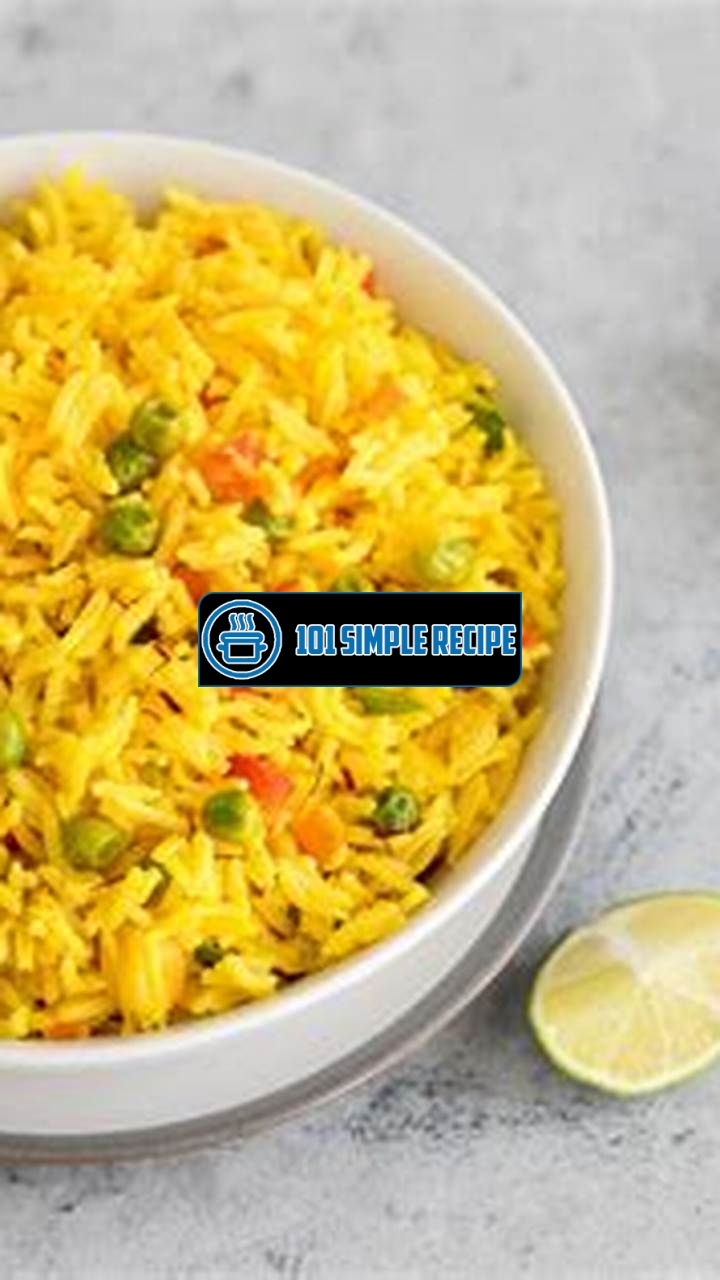Get ready for a culinary adventure that will transport your taste buds to the vibrant streets of Thailand with Thai Yellow Rice. This aromatic and flavorful dish has become a favorite among food enthusiasts around the world. Carefully crafted with a harmonious blend of spices such as turmeric, cinnamon, and cardamom, Thai Yellow Rice offers a tantalizing combination of sweet, savory, and subtly spicy flavors. ️ Once you take a bite, you’ll be hooked! Whether you’re a fan of Thai cuisine or simply seeking to explore new flavors, Thai Yellow Rice is an irresistible choice that brings a burst of excitement to any dining experience.

The Origin of Thai Yellow Rice
Discover the rich history of Thai yellow rice and its cultural significance in Thai cuisine.
The Traditional Roots of Thai Yellow Rice
Thai yellow rice, also known as khao pad pong karee, is a traditional Thai dish that has been enjoyed for centuries. It is believed to have originated in southern Thailand, where rice is a staple food. This vibrant yellow dish is a favorite among locals and visitors alike, thanks to its unique flavor and beautiful presentation.
In the past, Thai yellow rice was often prepared for special occasions and festivals. It was considered a symbol of prosperity and good luck. The dish was traditionally served at weddings, birthdays, and other important ceremonies. Today, it can be found on the menus of many Thai restaurants around the world.
Thai yellow rice is typically made using jasmine rice, which is known for its fragrant aroma and delicate flavor. The rice is cooked with a variety of ingredients to create its signature yellow color, including turmeric, coconut milk, and spices. The combination of flavors creates a delicious and satisfying dish that is full of depth and complexity.
The Yellowing Ingredient: Turmeric
Turmeric is the key ingredient that gives Thai yellow rice its vibrant color. This versatile spice is widely used in Thai cooking and is known for its earthy flavor and numerous health benefits. Turmeric contains a compound called curcumin, which is believed to have anti-inflammatory and antioxidant properties.
In addition to adding color to dishes, turmeric also provides a unique flavor to Thai yellow rice. It adds a warm and slightly bitter taste, which complements the other ingredients in the dish. Turmeric is also known for its digestive properties and is often used in Thai cuisine to aid digestion.
When cooking Thai yellow rice, it is important to use a good quality turmeric powder to ensure a vibrant yellow color and rich flavor. The turmeric should be dissolved in coconut milk or water before adding it to the rice, as this helps to evenly distribute the color and flavor throughout the dish.
The Symbolic Meanings of Thai Yellow Rice
In Thai culture, food holds deep symbolic meanings, and Thai yellow rice is no exception. The vibrant yellow color of the dish is associated with wealth, prosperity, and happiness. It is often served on auspicious occasions as a symbol of good fortune and blessings.
Thai yellow rice is also considered a celebratory dish and is often served during festivals and important events. It is believed that consuming yellow rice brings luck and joy to those who partake in it. The dish is often shared with loved ones, reinforcing the importance of community and togetherness.
Furthermore, the combination of turmeric, which is believed to have healing properties, and rice, a staple food, represents nourishment and well-being. Thai yellow rice is not only a delicious culinary creation, but it is also a cultural symbol that reflects the values and traditions of Thailand.
If you’re looking for other tasty recipes, you might enjoy our Thai fried rice recipe. It’s a flavorful and satisfying dish packed with fresh ingredients.
The Art of Making Thai Yellow Rice
Uncover the step-by-step process of preparing authentic Thai yellow rice.
Choosing the Right Rice Variety
When it comes to making Thai yellow rice, choosing the right rice variety is crucial in achieving the perfect texture and flavor. The most commonly used rice for this dish is jasmine rice. Known for its delicate aroma and fluffy texture, jasmine rice is the ideal choice.
In addition to jasmine rice, you can also experiment with other varieties such as basmati rice or long-grain rice. These types of rice have similar characteristics to jasmine rice and can provide a satisfactory result.
Important Note: Regardless of the rice variety you choose, remember to rinse it thoroughly before cooking to remove any excess starch.
Preparing the Turmeric Infusion
The vibrant yellow color of Thai yellow rice comes from turmeric, a spice widely used in Thai cuisine. To infuse the rice with this beautiful hue, you’ll need to prepare a turmeric infusion.
Here’s how you can do it:
- Take a small saucepan and add water to it. For every cup of rice, use 2 and a half cups of water.
- Add turmeric powder to the water and bring it to a boil. You’ll need about 1 teaspoon of turmeric powder for every cup of rice.
- Once the water is boiling, reduce the heat to low and let it simmer for about 5 minutes. This will help release the flavor and color of the turmeric.
- After 5 minutes, turn off the heat and let the turmeric infusion cool down.
Remember: The turmeric-infused water will be the base for cooking your rice, so make sure it’s well-infused and flavorful.
Cooking Techniques for Perfectly Flavored Rice
Now that you have your rice variety and turmeric infusion ready, it’s time to cook the perfect Thai yellow rice. Here are some essential cooking techniques to ensure your rice is flavorful and fluffy.
- Start by heating a large pot over medium heat. Add a tablespoon of oil or butter to the pot.
- Once the oil or butter is heated, add the rinsed rice to the pot and stir it gently for a few minutes. This step helps to coat the rice grains with oil, enhancing their flavor.
- Next, pour the turmeric infusion into the pot, making sure the rice is fully submerged in the liquid.
- Bring the mixture to a boil and then reduce the heat to low, covering the pot with a tight-fitting lid.
- Let the rice simmer for about 15-20 minutes, or until all the liquid is absorbed and the rice is tender.
- Once the rice is cooked, fluff it with a fork to separate the grains and distribute the vibrant yellow color evenly.
Note: To add extra flavor and texture, you can also incorporate aromatic ingredients such as lemongrass, pandan leaves, or kaffir lime leaves to the rice while cooking.
By following these steps and techniques, you can confidently prepare a delicious batch of Thai yellow rice that will impress your family and friends. Enjoy the irresistible flavor of this fragrant and vibrant dish!
Looking for a unique twist on traditional rice recipes? Try our Thai sticky rice recipe. It’s a delightful and sticky treat that pairs perfectly with your favorite Thai dishes.
Flavors and Aromas of Thai Yellow Rice
Thai yellow rice is a beloved dish that captivates taste buds and entices with its enticing aromas. This flavorful rice dish is a staple in Thai cuisine and is known for its vibrant colors and delectable taste profile. Let’s delve deeper into the flavors and aromas that make Thai yellow rice so popular.
The Warmth of Turmeric
Turmeric, often referred to as the “golden spice,” is a key ingredient that gives Thai yellow rice its warm and inviting flavor. This bright yellow spice not only imparts a beautiful hue to the rice but also adds a subtle earthy and slightly peppery taste. Its warm notes create a comforting sensation that is reminiscent of home-cooked meals.
Turmeric is also known for its numerous health benefits. It is rich in antioxidants and has anti-inflammatory properties, making it a valuable addition to any diet. Incorporating turmeric into your meals not only enhances flavor but also promotes wellness.
The Fragrance of Pandan Leaves
Adding to the delightful aroma of Thai yellow rice is the use of pandan leaves. These vibrant green leaves are often tied into a knot and added to the rice while cooking. As the rice steams, the pandan leaves release their enticing fragrance, infusing the grains with a subtle floral scent.
The fragrant pandan leaves impart a unique and refreshing aroma that enhances the overall sensory experience of Thai yellow rice. The combination of the warm turmeric and the floral fragrance of pandan leaves creates a delightful symphony of scents that is truly irresistible.
The Subtle Sweetness of Coconut Milk
Coconut milk is another essential ingredient in Thai yellow rice that contributes to its mouthwatering flavor. The creamy and rich texture of coconut milk provides a luscious base for the rice, while its natural sweetness enhances the overall taste profile.
The subtle sweetness of coconut milk complements the warm notes of turmeric and the floral fragrance of pandan leaves. It adds depth and balance to the dish, creating a harmonious blend of flavors that keeps you coming back for more.
Additionally, coconut milk is a common ingredient used in Thai cuisine due to its versatility and nutritional value. It is a source of healthy fats and provides a creamy texture to various dishes, making it a popular choice among chefs and home cooks alike.
In conclusion, Thai yellow rice offers a symphony of flavors and aromas that tantalize the senses. The warmth of turmeric, the fragrance of pandan leaves, and the subtle sweetness of coconut milk come together to create a truly irresistible dish. Whether enjoyed as a main course or as a side dish, Thai yellow rice is sure to please even the most discerning palates.
The Versatility of Thai Yellow Rice
Thai yellow rice is a versatile and flavorful dish that can be enjoyed in a variety of ways. From stir-fries to traditional festivals, Thai yellow rice takes the center stage in many delicious recipes. Let’s explore some of the ways you can incorporate this irresistible rice into your meals.
Stir-Fried Thai Yellow Rice with Vegetables
One of the most popular ways to enjoy Thai yellow rice is by stir-frying it with an array of colorful and nutritious vegetables. This dish is not only visually appealing but also packed with flavors. The soft and fluffy texture of the rice pairs perfectly with the crunchy vegetables, creating a delightful contrast. You can add your favorite vegetables such as carrots, peas, bell peppers, and broccoli, and sauté them with aromatic spices like garlic, ginger, and turmeric. The result is a vibrant and flavorful dish that can be enjoyed on its own or as a side dish.
Thai Yellow Rice with Grilled Meats
For meat lovers, Thai yellow rice provides a fantastic base for grilled meats. The bold and fragrant flavors of the rice elevate the taste of grilled meats, creating a mouthwatering combination. Whether it’s chicken, beef, or seafood, you can marinate your choice of protein with Thai spices like lemongrass, chili, and coriander, and then grill it to perfection. Serve the grilled meat on a bed of Thai yellow rice, and you’ll have a satisfying and flavorful meal that will tantalize your taste buds.
Thai Yellow Rice in Traditional Festivals
Thai yellow rice also holds a special place in traditional Thai festivals. During cultural celebrations and religious ceremonies, Thai yellow rice is commonly prepared and shared among friends and family. It symbolizes prosperity, good fortune, and abundance. One such festival is the Thai New Year, also known as Songkran, where Thai yellow rice is a staple on the dining table. The vibrant yellow color of the rice represents the sun and is believed to bring luck and happiness for the coming year.
Other festivals such as Loy Krathong, which involves floating lanterns on water, and the Yi Peng Festival, where thousands of lanterns are released into the sky, also incorporate Thai yellow rice as part of the festivities. It is often served alongside other traditional dishes, creating a feast for the senses.
In conclusion, the versatility of Thai yellow rice is truly remarkable. From stir-fries to grilled meats and traditional festivals, this flavorful dish offers a unique and delightful experience. Whether you’re looking for a comforting meal at home or want to immerse yourself in the rich Thai culture, incorporating Thai yellow rice into your culinary repertoire is a fantastic choice. Give it a try and let the irresistible flavors transport you to the vibrant streets of Thailand.
For more delicious recipes, check out our Thai yellow rice recipe. It’s a perfect side dish for any meal.
Health Benefits of Thai Yellow Rice
When it comes to Thai cuisine, one dish that stands out for its vibrant color and delicious flavor is Thai yellow rice. Not only is it a feast for the senses, but it also offers numerous health benefits. From curcumin’s anti-inflammatory properties to boosting digestive health and promoting heart health, Thai yellow rice is a nutritious addition to any diet.
Curcumin’s Anti-inflammatory Properties
One of the key ingredients in Thai yellow rice is turmeric, which contains an active compound called curcumin. Curcumin has powerful anti-inflammatory properties that have been used in traditional medicine for centuries. It can help reduce inflammation in the body, which is beneficial for people with conditions such as arthritis, inflammatory bowel disease, and even certain types of cancer.
✨ Fun fact: Curcumin gives turmeric its yellow color.
Boosting Digestive Health
Thai yellow rice is not just a flavorful addition to your plate; it also provides important benefits for your digestive system. The combination of turmeric, spices, and rice can help improve digestion and prevent issues such as bloating and indigestion. Turmeric has long been used in traditional medicine to treat digestive ailments and promote overall gut health.
✨ Did you know? Turmeric has been used as a natural remedy for stomach ulcers.
Promoting Heart Health
Incorporating Thai yellow rice into your diet can also have positive effects on your cardiovascular health. The turmeric in the dish contains compounds that may help reduce cholesterol levels and regulate blood pressure. By including Thai yellow rice as part of a balanced diet, you can support a healthy heart and reduce the risk of heart disease.
✨ Remember: A healthy heart is key to long-term well-being.
In conclusion, Thai yellow rice offers a range of health benefits that make it more than just a tasty dish. From the anti-inflammatory properties of curcumin to its ability to boost digestive and heart health, including Thai yellow rice in your meals can support your overall well-being. So why not give this flavorful and nutritious rice a try? Your taste buds and your body will thank you!
Thank you for taking the time to read about Thai Yellow Rice. We hope you found this article informative and inspiring. If you’re craving a flavorful and aromatic dish that will transport you to the vibrant streets of Thailand, give this recipe a try. Remember to bookmark our site and visit again later for more exciting culinary adventures. Happy cooking!
Frequently Asked Questions
Here are some common questions about Thai Yellow Rice:
| No. | Questions | Answers |
|---|---|---|
| 1. | What is Thai Yellow Rice? | Thai Yellow Rice is a fragrant and flavorful rice dish made with jasmine rice, turmeric, and other aromatic ingredients. It is a popular side dish in Thai cuisine and pairs well with various curries and grilled meats. |
| 2. | How do you make Thai Yellow Rice? | To make Thai Yellow Rice, start by rinsing the jasmine rice until the water runs clear. Then, cook the rice with coconut milk, turmeric, and other spices to infuse it with vibrant flavors. Fluff the cooked rice with a fork and serve it hot. |
| 3. | Can I substitute regular rice for jasmine rice in this recipe? | While jasmine rice is traditionally used for Thai Yellow Rice, you can substitute it with other long-grain rice varieties. However, keep in mind that the texture and flavor may differ slightly. |
| 4. | What dishes pair well with Thai Yellow Rice? | Thai Yellow Rice pairs beautifully with a variety of Thai dishes, such as Massaman Curry, Green Curry, or Pineapple Fried Rice. It also complements grilled meats like lemongrass chicken or satay skewers. |
| 5. | Can I make Thai Yellow Rice in advance? | Yes, you can make Thai Yellow Rice in advance and reheat it before serving. Make sure to store it in an airtight container in the refrigerator and reheat it gently in the microwave or on the stovetop with a bit of water to moisten it. |
| 6. | Is Thai Yellow Rice gluten-free? | Yes, Thai Yellow Rice is gluten-free as long as you use gluten-free ingredients, such as gluten-free soy sauce and check the labels of any pre-made curry pastes or sauces for gluten-containing ingredients. |
Experience the Flavors of Thailand with Thai Yellow Rice
Indulge in the irresistible aroma and taste of Thai Yellow Rice. This vibrant and fragrant dish will transport you to the bustling streets of Thailand with every bite. The combination of turmeric, coconut milk, and jasmine rice creates a symphony of flavors that will tantalize your taste buds. Whether you’re serving it as a side dish or as the star of the meal, Thai Yellow Rice is sure to impress. So gather your ingredients, follow our easy recipe, and immerse yourself in the vibrant world of Thai cuisine. Don’t miss out on this culinary adventure!
Jump to Recipe
Thai Yellow Rice

Experience the vibrant flavors of Thai cuisine with this fragrant and delicious Thai Yellow Rice recipe.
- 2 cups jasmine rice
- 1 can (13.5 oz coconut milk)
- 1 teaspoon turmeric powder
- 1 teaspoon salt
- 2 tablespoons chopped cilantro
- 1 tablespoon chopped scallions
- Place the jasmine rice in a fine-mesh sieve and rinse it under cold water until the water runs clear. Drain well.
- In a medium saucepan, combine the rinsed rice, coconut milk, turmeric powder, and salt. Bring to a boil over medium heat, then reduce the heat to low, cover, and simmer for 15-20 minutes or until the rice is tender and the liquid is absorbed.
- Remove the saucepan from the heat and let the rice sit, covered, for 5 minutes. Fluff the rice with a fork, then transfer it to a serving dish. Garnish with chopped cilantro and scallions. Serve hot and enjoy!






